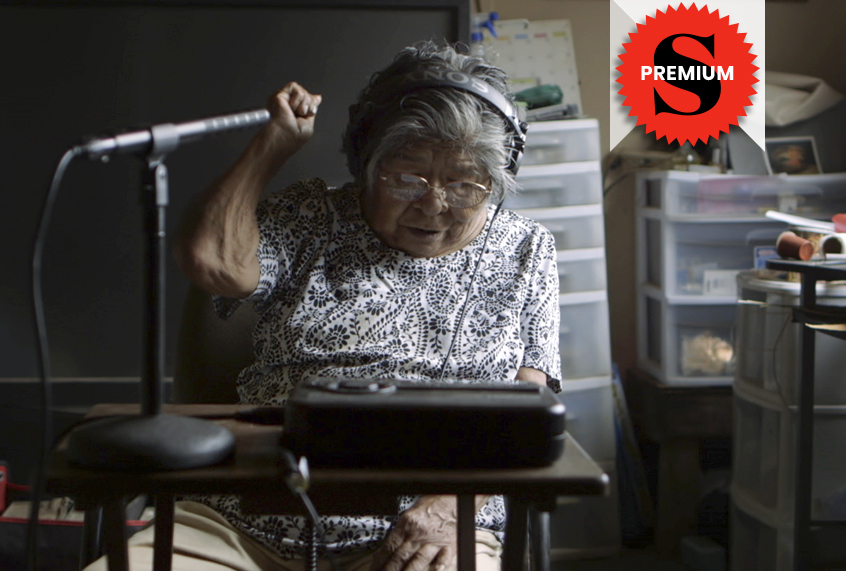The title of Emmanuel Vaughan-Lee’s film, “Marie’s Dictionary,” may not make it sound as thrilling as “The Last of the Mohicans,” but it has as much resilient spirit — and, possibly, character development — as that drama from 1992. The short documentary brings us into the home of elderly grandma, Marie Wilcox, who has been endeavoring to keep her native Wukchumni language alive through the creation of a written and oral dictionary.
You can watch the full documentary, “Marie’s Dictionary,” on Salon Premium, our new ad-free, content-rich app. Here’s how.
Salon talked to Vaughan-Lee about the creation of “Marie’s Dictionary,” the state of Native American languages and the film’s indelible subject.
Who are the Wukchumni?
The Wukchumni are a non-federally recognized Native American tribe from the Central California region. They are part of the broader Yokuts tribal group. Prior to European contact, as many as 50,000 Yokuts lived in the region, but those numbers have steadily decreased. Today, it is estimated that less than 200 Wukchumni remain.
How long did [it take] you to shoot the film? What was it like being with Wilcox?
The film was shot over the course of five days. Prior to filming, I had spent a few days with Marie Wilcox and her daughter Jennifer Malone, getting to know them both. Marie and Jennifer were a joy to spend time with. They welcomed us into their home, shared their lives and stories with us and made us feel like family. Marie is humble, kind and gracious — a truly remarkable person who has worked tirelessly to preserve her language for future generations. It was an honor to be able to film and share her story.
Can you tell us a little about the general state of Native American languages — what’s happening to them and if there are any effective government, non-profit or academic programs to keep them alive?
In the United States, 130 Native American languages are currently at risk, with 74 considered critically endangered. Many of those considered critical have only a few fluent speakers remaining. Since European contact, Native American peoples have been subject to cycles of oppression and colonization that have impacted their cultures and languages. They were often banned from speaking their languages, and youth were separated from their parents and grandparents and sent to residential boarding schools where speaking their native languages was forbidden. The impacts of this are still being felt today.
But despite this, throughout North America, indigenous languages are being revived and restored. Tremendous efforts are underway to teach new generations of language speakers and reclaim what was lost and taken from these peoples. There are numerous effective programs working to support this revival, especially at the tribal level and among the non-profit sector. The organization that first connected me to Marie Wilcox, the Advocates for Indigenous California Language Survival, is one such program. Through training and mentorship, they work to support fluent speakers like Marie, to pass along their language to their tribal communities,
Do you have an update on Wilcox, her family and her language project and classes?
Marie and Jennifer are both doing well. In the four years since we shot the film, her family and members of her tribe have shown renewed interest in learning Wukchumni and honoring her work. Marie and Jennifer continue to help teach language classes to their tribe.
How have Wilcox’s dictionary and classes inspired other tribes to keep their languages alive?
I think more than anything, Marie’s story served as an inspiration to other indigenous language restoration programs and efforts around the world. The methods of creating a dictionary and companion audio recordings were not new. It was how she did it, and the power of her determination to keep the Wukchumni language alive for future generations, that I think touched so many people working in the indigenous language revitalization movement.
What are you working on now?
I just released my first virtual reality film, a piece called “Sanctuaries of Silence.” The film is an immersive listening journey into the Hoh Rainforest, one of the quietest places in North America. It played at New York Film Festival and SXSW Film Festival and just had its online premiere on The New York Times Op-Docs.
I also have a new film called “Earthrise” premiering at Tribeca Film Festival later this month. It tells the story of the first image captured of the Earth from space in 1968. Told solely by the Apollo 8 astronauts, the film recounts their experiences and memories and explores the beauty, awe and grandeur of the Earth against the blackness of space.
Check out an incredible — mostly sad but also inspiring — chapter in a Native people’s history and one woman’s struggle to retain what’s been nearly lost. Watch “Marie’s Dictionary” on Salon Premium, our new ad-free, content-rich app.
Reading this in the app already? Go back to the main menu and select “SalonTV” to find Salon Films and Salon original shows.

